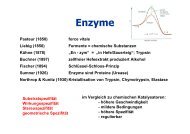Transglutaminase-1 and Bathing Suit Ichthyosis: Molecular Analysis ...
Transglutaminase-1 and Bathing Suit Ichthyosis: Molecular Analysis ...
Transglutaminase-1 and Bathing Suit Ichthyosis: Molecular Analysis ...
You also want an ePaper? Increase the reach of your titles
YUMPU automatically turns print PDFs into web optimized ePapers that Google loves.
K Aufenvenne et al.<br />
<strong>Molecular</strong> <strong>Analysis</strong> of Gene/Environment Interactions<br />
Slope (∆A/minute)<br />
Slope (∆A/minute)<br />
3.5<br />
3<br />
2.5<br />
2<br />
1.5<br />
1<br />
0.5<br />
0<br />
0.35<br />
0.3<br />
0.25<br />
0.2<br />
0.15<br />
0.1<br />
0.05<br />
0<br />
92 kDa<br />
43 kDa<br />
a wide temperature range with an<br />
optimum at 37 1C (Figure 1c). The<br />
mutations described for generalized LI<br />
display a strong decrease of activity<br />
(Figure 1d <strong>and</strong> e) without a clear<br />
optimum. All BSI mutations showed a<br />
decrease of activity <strong>and</strong> a shift of the<br />
temperature optimum from 37 to 31 1C.<br />
In all cases, the residual activity ranged<br />
between 13 <strong>and</strong> 16.5% at 31 1C,<br />
Arg264Gln<br />
Relative fold (a.u.)<br />
Arg315His<br />
1<br />
0.8<br />
0.6<br />
0.4<br />
0.2<br />
0<br />
Arg687His<br />
Arg264Gln<br />
Arg315His<br />
Temperature (°C)<br />
Arg142His<br />
Arg687His<br />
Arg142His<br />
Arg264His<br />
Arg389Pro<br />
Arg264Trp<br />
Arg389Pro<br />
Arg315Cys<br />
Arg315Cys<br />
Arg126Cys<br />
Arg126Cys<br />
Arg307Gly<br />
Tyr276Asn<br />
Arg307Gly<br />
0.78<br />
0.7 0.65 0.68<br />
0.85 0.81 0.91<br />
0.64 0.77<br />
0.56<br />
Wild type<br />
25 27 29 31 33 35 37 39 41 43 45<br />
Arg307Gly Arg389Pro<br />
25 27 29 31 33 35 37 39 41 43 45<br />
Temperature (°C)<br />
Tyr276Asn<br />
Ser358fsX26<br />
Ser258fsX26<br />
lacZ<br />
WT<br />
whereas the activity at 37 1C was<br />
reduced to o7.5% (Figure 1d <strong>and</strong> e).<br />
Interestingly, seven of the eight BSI<br />
mutations are related to arginine<br />
substitutions. This residue is often involved<br />
in electrostatic interactions or<br />
hydrogen bonds <strong>and</strong> is referred to as<br />
easily mutated due to the deamination<br />
of 5 0 -CpG dinucleotides (Cooper<br />
<strong>and</strong> Youssoufian, 1988). Structural<br />
1<br />
lacZ<br />
WT<br />
TG1<br />
Actin<br />
Relative activity (%)<br />
wt<br />
77.76<br />
100<br />
Tyr276Asn<br />
4.58<br />
14.55<br />
Arg687His<br />
7.58<br />
16.50<br />
37 °C<br />
31 °C<br />
Arg307Gly<br />
6.37<br />
13.87<br />
Arg389Pro<br />
2.59<br />
5.04<br />
Arg126Cys<br />
7.41<br />
13.00<br />
Arg142His<br />
3.01<br />
5.47<br />
Arg264Trp<br />
5.67<br />
12.98<br />
Arg264Gln<br />
5.45<br />
13.39<br />
Arg315Cys<br />
5.59<br />
13.99<br />
Arg315His<br />
6.25<br />
13.48<br />
n=5<br />
0 10 20 30 40 50 60 70 80 90100 110<br />
Figure 1. Expression (a <strong>and</strong> b) <strong>and</strong> activity (c–e) of recombinant transglutaminase-1 (TGase-1) mutants. HEK 293 cells were transiently transfected with 8 mg of<br />
pcDNA3.1( þ ) constructs containing wild-type or mutant TGase-1 or the b-galactosidase (lacZ) coding region using the Nanofectin transfection Kit according to<br />
the manufacturer’s instructions (PAA, Cölbe, Germany). (a) Total protein of 15 mg was subjected to a discontinuous 10% SDS-PAGE under reducing conditions<br />
<strong>and</strong> afterward transferred onto a PVDF membrane (Immobilin P, Millipore, Eschborn, Germany). Western blot was developed using polyclonal antibodies raised<br />
against TGase-1 (1:2,000, N-Zyme BioTec, Darmstadt, Germany). Anti-actin antibodies were used as a control. (b) Protein levels were determined by<br />
densitometric quantification (ImageQuant, <strong>Molecular</strong> Dynamics, San Franciso, CA) <strong>and</strong> normalized to wild-type values, set as 1 in arbitrary units (a.u.). All<br />
transfections were performed in triplicate. (c–e) The activity of TGase-1 mutants <strong>and</strong> wild type were analyzed by fluorescence spectrometry. Total protein of 5 mg<br />
was incubated in pre-warmed assay buffer <strong>and</strong> the activity was measured for 15 minutes. TGase-1 activity is the slope of the arithmetic mean of five<br />
measurements (n ¼ 5). Lysates of untransfected cells were used as a negative control. (c) Wild type; (d) examples for mutations described earlier in patients with<br />
lamellar ichthyosis type 1 (Arg389Pro) <strong>and</strong> mutations causing the BSI phenotype (Arg307Gly); (e) relative activity (%) of mutant TGase-1 proteins in comparison<br />
with the wild type at 37 <strong>and</strong> 31 1C. All BSI mutations show an activity above 10% at their temperature optimum at 31 1C <strong>and</strong> a dramatic decrease at 37 1C when<br />
compared with the wild type. The two mutations, Arg142His <strong>and</strong> Arg389Pro, described before in patients with generalized LI type 1 show a dramatic decrease<br />
of activity at both temperatures.<br />
2 Journal of Investigative Dermatology<br />
modeling based on the atomic structure<br />
of other TGases suggested that particular<br />
BSI mutations do not result in a<br />
major change of TGase-1 structure or<br />
protein folding (Oji et al., 2006;<br />
Figure 2). We postulate that BSI<br />
mutations could influence hydrogen<br />
bonding, as several mutations (for<br />
example, Tyr276Asn, Arg264Trp,<br />
Arg264Gln, Arg307Gln, <strong>and</strong>




